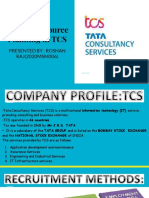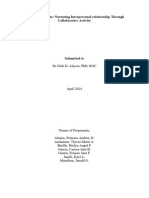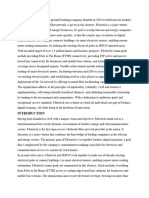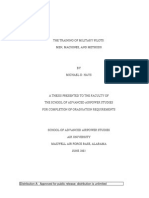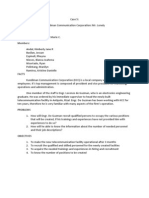Training Methods of Reliance
Training Methods of Reliance
Uploaded by
Sanika AcharyaCopyright:
Available Formats
Training Methods of Reliance
Training Methods of Reliance
Uploaded by
Sanika AcharyaOriginal Description:
Copyright
Available Formats
Share this document
Did you find this document useful?
Is this content inappropriate?
Copyright:
Available Formats
Training Methods of Reliance
Training Methods of Reliance
Uploaded by
Sanika AcharyaCopyright:
Available Formats
Introduction
Tesco is the largest British retailer and is also the world's third largest grocery retailer with outlets across Europe, USA and Asia. The business began in 1919 with one man, Jack Cohen, selling groceries from a stall in the East End of London. Jack bought surplus stocks of tea from a company called T.E. Stockwell. T.E. Stockwell and Cohen combined their names to brand the tea Cohen originally sold TESCO tea. In 1929, the first Tesco store opened in north London. Tesco has expanded since then by a combination of acquisition of new stores, retail services and by adapting to the needs of consumers. Tesco has net profits (before tax) of around 3 billion. Tesco's primary aim is 'to serve the customer'. Keeping existing customers happy is important, as they are more likely to return. This is more cost effective for the business than acquiring new ones. In the UK Tesco now has over 2,200 stores ranging from the large Extra hypermarket style stores to small Tesco Express high street outlets. Tesco's original product range of grocery and general merchandise has diversified to include banking, insurance services, electrical goods as well as telephone equipment and airtime. This move towards 'one stop shopping' means customers can meet all their purchasing needs from one place. Tesco has also expanded its customer base through its Tesco.com website which attracts one million regular users.
As the company has grown, so has its workforce. From one man and a stall, Tesco now has approximately 280,000 employees in the UK and over 460,000 worldwide. To serve its widening markets it needs flexible and well-trained staff that can recognise the needs of the customer.
Tesco's employees work in a wide range of roles in both store and non-store functions, such as: Customer Assistants on the shop floor either directly assisting customers or preparing orders for delivery to customers who have ordered online Department Managers leading a team of Customer Assistants Warehouse employees who help catalogue and store clothing, food or brown goods in Tesco Distribution Centres or in stores Office-based staff working in a range of functions at Head Office, including Finance, Purchasing, Personnel or Marketing Logistics staff who plan and carry out the distribution of products to stores. Tesco recognises that increasing knowledge, improving skills and job satisfaction of employees are all vital to the continued growth of the company. This case study looks at how Tesco provides training and developmentopportunities for its employees.
Identifying training needs
Tesco's aim to expand and diversify requires the business to have the right people, in the right place, at the right time. Many factors affect workforce planning: The opening of new stores in new locations means that Tesco must adapt to different demands made by consumers. For instance, stores in highly populated diverse areas may need to sell a high proportion of speciality goods to meet the requirements of its customers, so selecting that stock requires a clear understanding of the customer profile in that area. In-store and non-store based posts may require different technical skills and competencies. Employees with a wide skills range who can work flexibly are more productive for the business. Tesco employs people from a wide range of backgrounds and all employees have the opportunity to grow and develop. Tesco regularly evaluates the performance of its employees in order to anticipate any possible skills shortages. This helps managers and
employees decide whether they have the correct knowledge, skills, understanding and resources to carry out their job effectively. Through annual reviews and career discussions, employees are able to apply for training suited to their needs. For example, managers in stores, Distribution Centres and Head Office can spend a week in a store together, learning about each other's work. This makes each part of the Tesco operation more robust.
The Tesco Leadership Framework focuses on three key themes to guide appropriate behaviour in employees. These link to nine critical success factors, which break down further into various levels of assessment. This framework helps to identify those employees with the potential to be the 'best leaders of the future'. Tesco sees it as a priority to develop leadership at every level in every part of the business. In the last year over 2,900 managers, of which 85% were internal promotions, were appointed in the UK and thousands more employees promoted. One in every 10 Tesco employees takes part in development activities and as many as one in 30 are on its Options programme. Before undertaking training and development, employees identify gaps in their knowledge and skills. The gaps identified are logged in a Personal Development Plan. Employees and line managers decide how they will fill these gaps by training or development activities. Tesco's training and development programmes enable all employees to develop the skills they need to get on in their careers.
Training
Training is the acquisition of knowledge and skills in order for a person to carry out a specific task or job. Training benefits employees in several ways:
It increases their sense of ownership in the business. They become more organised, productive and flexible and are better able to meet the needs of internal and external customers. New skills and abilities in areas such as decision-making can empower staff, which makes them more effective. Tesco's business image also benefits as customers are more confident in the competence and knowledge of staff. This in turn helps Tesco grow.
Tesco has a flexible and structured approach to training and development, which adapts to individual employee needs. This allows people identified as having the potential and desire to do a bigger or different role to take part in training to develop their skills and leadership capability. Tesco offers employees both on-the-job training and off-the-job training. On-the-job training methods at Tesco include: shadowing a person already in the job shows the employee how to do it coaching a manager or designated colleague will help trainees work through problems and inspire them to find solutions mentoring a more experienced member of staff acts as an adviser job rotation orsecondment the trainee has the opportunity of covering their target role, taking full responsibility on a temporary or limited basis. For the employee, on-the-job training is directly relevant to their work, they get to know the people in their area and feel part of the team faster. On-the-job training also has several advantages for the company: It is cheaper than off-the-job training. Managers see progress and can help when problems arise to resolve them quickly. The employee is still working during training so is more productive. The employee puts learning into practice. Off-the-job training is often more appropriate for training in specific new skills or for developing the individual, in areas such as team-building, communications (for example, making presentations), or organisation and planning. It usually involves attending external courses run by professional training organisations or qualified Tesco training staff.
T he A-level Options programme for developing new recruits into managers provides detailed induction training from day one. This enables new employees to meet other trainees and learn about the company and the business objectives rapidly. With a rapid training schedule, they are able to develop to their first level management position whilst working as a Team Leader in a store within six months.
Development
Development is about helping the person grow and extend their abilities. Tesco takes a shared responsibility approach to training and development. The trainee is primarily responsible for his or her development. Both the trainee and the line manager contribute to the programme. Tesco employees are encouraged to ask themselves strategic questions in order to assess their skills and ability to progress: Do I know how? Can I do it now? What are my current skills? What do I need to achieve a higher position? Tesco's Options programme provides a long-term strategy for development. It offers, for example, workshops focusing on both leadership behaviours and operating skills. The employee's Personal Development Plan includes Activity Plans, a Learning Log (to record what the key learning points of the training were and how they are going to be used) and a 'Plan, Do, Review' checklist to monitor when plans are completed. This allows trainees to carry out their own analysis of progress.
Personal development helps to produce long lasting competencies. This means employees become more positive, productive and valuable to the organisation in the long term. Recruiting new staff is more expensive than retaining existing staff, so for Tesco, retaining staff is extremely important. Development also helps increase the level of employee motivation. Motivation theorists suggest that if people are given the skills to do their jobs well, the support to grow their abilities and greater responsibility, this makes them more effective in their roles. Tesco requires staff who can be flexible and who can adapt to change. It also needs to ensure it has the right calibre of staff to build its management team of the future.
Conclusion
Efficient and effective training and development of employees is an essential element for Tesco's continuing growth in an increasingly commercial world. Tesco requires employees who are committed and flexible in order to aid its expansion of the business. The expansion of Tesco relies on retaining existing customers and acquiring new ones. All customers need to be confident and happy in Tesco. This relies on committed and flexible employees delivering the highest standards of service to meet Tesco's objectives. Tesco's structured approach to training and developing its existing and new employees provides a strong foundation for its continuing growth.
Read more: http://businesscasestudies.co.uk/tesco/how-training-and-developmentsupports-business-growth/conclusion.html#ixzz2HHErsFdT Follow us: @Thetimes100 on Twitter | thetimes100casestudies on Facebook
You might also like
- Assignment DMBA104 MBA 1 Set-1 and 2 Jan-Feb 2023Document6 pagesAssignment DMBA104 MBA 1 Set-1 and 2 Jan-Feb 2023Nihar KambleNo ratings yet
- Project Report On DaburDocument100 pagesProject Report On Daburrohit_n16100% (2)
- Financial MGMT MBA 2nd SemDocument188 pagesFinancial MGMT MBA 2nd Semnimala maniNo ratings yet
- Innovative HR Practices of Indian CompaniesDocument5 pagesInnovative HR Practices of Indian CompaniesSneha ShendeNo ratings yet
- Mba Project Report On HDFC BankDocument17 pagesMba Project Report On HDFC BankSai YaminiNo ratings yet
- Types of Ratio AnalysisDocument4 pagesTypes of Ratio Analysis1526Darshan KanchiNo ratings yet
- 12 Performance QuestionsDocument5 pages12 Performance QuestionsDinescu FlorentaNo ratings yet
- International Monetary System For MBA, BBA, B.Com StudentsDocument16 pagesInternational Monetary System For MBA, BBA, B.Com StudentsRavishJi100% (1)
- Hindustan UnilverDocument8 pagesHindustan UnilverTara ShankarNo ratings yet
- Managerial Economics Paper Kmbn102-2022Document2 pagesManagerial Economics Paper Kmbn102-2022Candy ManNo ratings yet
- Onicra Credit Rating AgencyDocument2 pagesOnicra Credit Rating AgencyAvtar SinghNo ratings yet
- Human Resource Planning by TCSDocument14 pagesHuman Resource Planning by TCSPramit MandalNo ratings yet
- Marketing MixDocument8 pagesMarketing MixinvestokingNo ratings yet
- Unit 12 Sick Industrial UnitDocument17 pagesUnit 12 Sick Industrial UnitGinu George VargheseNo ratings yet
- Manpower Policy and Human Resource PlanningDocument16 pagesManpower Policy and Human Resource Planningssac_1No ratings yet
- A Study On Employee Welfare Measures in BhelDocument19 pagesA Study On Employee Welfare Measures in BhelLovely ashwinNo ratings yet
- Summer Internship Project On OSCBDocument32 pagesSummer Internship Project On OSCBSunil ShekharNo ratings yet
- Job Evaluation Methods - Study MaterialDocument10 pagesJob Evaluation Methods - Study Materialjyothi vaishnavNo ratings yet
- LNMI MBA Syllabus 2020 FinalDocument157 pagesLNMI MBA Syllabus 2020 FinalAlok RajNo ratings yet
- Compensation Management: Components of Compensation SystemDocument9 pagesCompensation Management: Components of Compensation SystemgopareddykarriNo ratings yet
- Economic Costs of Imperfect CompetitionDocument15 pagesEconomic Costs of Imperfect Competitionsszr88No ratings yet
- External Reconstruction DefinitionDocument3 pagesExternal Reconstruction DefinitionTushar All Rounder67% (3)
- Career PlanningDocument9 pagesCareer PlanningNova BansalNo ratings yet
- Industry ProfileDocument5 pagesIndustry ProfileS.Abyisheik ReddyNo ratings yet
- Responsibility Accounting - Types, Features, Prerequisites & ExamplesDocument8 pagesResponsibility Accounting - Types, Features, Prerequisites & Examplesprakashzodpe2013No ratings yet
- UNIT-4 Mergers, Diversification and Performance EvaluationDocument13 pagesUNIT-4 Mergers, Diversification and Performance EvaluationRavalika PathipatiNo ratings yet
- Answers of Assignment Questions of Compensation ManagementDocument16 pagesAnswers of Assignment Questions of Compensation ManagementBaqirZarNo ratings yet
- SliceDocument65 pagesSliceNikhil VahitraNo ratings yet
- PatchingDocument17 pagesPatchingAarish Angrish100% (1)
- Tax Planning With Reference To New Business - NatureDocument26 pagesTax Planning With Reference To New Business - NatureasifanisNo ratings yet
- Unit-II Financial ServicesDocument20 pagesUnit-II Financial ServicesramamohanvspNo ratings yet
- Using Talent Management To Drive A Culture of ExcellenceDocument2 pagesUsing Talent Management To Drive A Culture of ExcellenceHARSHIT KUMARNo ratings yet
- Synopsis 00Document8 pagesSynopsis 00shalini TripathiNo ratings yet
- Notes.-Legal Systems. - IIPM. - MBA. & LCP FormDocument17 pagesNotes.-Legal Systems. - IIPM. - MBA. & LCP FormamitkaraliaNo ratings yet
- MHR Module 3Document41 pagesMHR Module 3Rossie KuhnNo ratings yet
- Unit 3 International BusinessDocument25 pagesUnit 3 International BusinessMrudul MuraliNo ratings yet
- Factoring Advantages and Dis AdvantagesDocument1 pageFactoring Advantages and Dis AdvantagesSiva RockNo ratings yet
- Organizational Study at ITI LTD, PalakkadDocument12 pagesOrganizational Study at ITI LTD, PalakkadVishnu S KumarNo ratings yet
- INCOME TAX Short ANSWERS by JURAZDocument11 pagesINCOME TAX Short ANSWERS by JURAZnourinck567No ratings yet
- Challenges Faced by Tata Motors: Tata Ace Challenge: Targeting The Bottom of PyramidDocument1 pageChallenges Faced by Tata Motors: Tata Ace Challenge: Targeting The Bottom of PyramidLijo MathewNo ratings yet
- Unit 3Document64 pagesUnit 3Senthil JS0% (1)
- Parallel Learning StructureDocument30 pagesParallel Learning StructurekunchadkaNo ratings yet
- Provisions Relating To Default in Furnishing Returns Under GSTDocument2 pagesProvisions Relating To Default in Furnishing Returns Under GSTsakshiNo ratings yet
- Talent ManagementDocument24 pagesTalent ManagementAbhishek jhaNo ratings yet
- SMCG Notes-1Document40 pagesSMCG Notes-1Basavaraj S PNo ratings yet
- Methods To Initiate Ventures From Idea To ActionDocument2 pagesMethods To Initiate Ventures From Idea To ActionEC Virtual DeskNo ratings yet
- Clpa Xii New Branches of AuditingDocument7 pagesClpa Xii New Branches of AuditingSARFARAZ AHMADNo ratings yet
- BBA (Hons) Internship FormatDocument8 pagesBBA (Hons) Internship FormatAreej AliNo ratings yet
- Objectives of Business Firm-FinalDocument43 pagesObjectives of Business Firm-FinalId Mohammad100% (3)
- Induction and OrientationDocument4 pagesInduction and OrientationKrishna KumarNo ratings yet
- Five Year Plan Wage PolicyDocument31 pagesFive Year Plan Wage Policypoojaarora_10_juneNo ratings yet
- Ingredients of A ReportDocument15 pagesIngredients of A ReportAastha JainNo ratings yet
- Financial Management Mba Question PaperDocument4 pagesFinancial Management Mba Question Paperpalak2407No ratings yet
- Vi Sem Bba Internship GuidelinesDocument8 pagesVi Sem Bba Internship GuidelinesPradeep PNo ratings yet
- Sadbhav Ruta YagnikDocument58 pagesSadbhav Ruta YagnikRuta YagnikNo ratings yet
- International HR PracticesDocument5 pagesInternational HR Practicesanshul bhardwajNo ratings yet
- Harsh Internship ReportDocument4 pagesHarsh Internship ReportNAVEEN ROYNo ratings yet
- Listing of SecuritiesDocument8 pagesListing of SecuritiesJeffry MahiNo ratings yet
- GROUP - 1 - A Project Report On PMS of Reliance IndustriesDocument14 pagesGROUP - 1 - A Project Report On PMS of Reliance IndustriesJawed Khan100% (1)
- GST Tally ERP9 English: A Handbook for Understanding GST Implementation in TallyFrom EverandGST Tally ERP9 English: A Handbook for Understanding GST Implementation in TallyRating: 5 out of 5 stars5/5 (1)
- Final Report Industrial Training (English) - 23Document52 pagesFinal Report Industrial Training (English) - 23Alvin AvinnashNo ratings yet
- PetroSkills O&MDocument12 pagesPetroSkills O&Mfoobar2016No ratings yet
- TR - Driving (Articulated) NC IIIDocument72 pagesTR - Driving (Articulated) NC IIIJayson FloresNo ratings yet
- Information Bulletin: Common Entrance Test - 2019Document99 pagesInformation Bulletin: Common Entrance Test - 2019Akshay KumariNo ratings yet
- Motorcycle Small Engine Servicing NC IIDocument162 pagesMotorcycle Small Engine Servicing NC IIhazzi100% (1)
- AUR05 ADocument125 pagesAUR05 Aabyzen100% (1)
- Chapter 8 Training and Developing EmployeesDocument41 pagesChapter 8 Training and Developing EmployeesFakZikriNo ratings yet
- Challenges of Training ManagersDocument2 pagesChallenges of Training ManagersTaief Mir100% (1)
- Structured Learning Experience Proposal FormatDocument5 pagesStructured Learning Experience Proposal Formatcbgarcia.chmsuNo ratings yet
- An Overview of FibertechDocument7 pagesAn Overview of FibertechTala SamerNo ratings yet
- Principles of HR ManagementDocument17 pagesPrinciples of HR ManagementELZININo ratings yet
- Iso 90012008 QMSDocument39 pagesIso 90012008 QMSlalitkasturiaNo ratings yet
- Ate JoyDocument38 pagesAte Joywilliamstorrible24No ratings yet
- Ai: Artificial Intelligence VR: Virtual Reality: Ahmad Aziz, Rayyan Aslam, Hadeer Umar, Abdullah Saeed Y8-B7Document6 pagesAi: Artificial Intelligence VR: Virtual Reality: Ahmad Aziz, Rayyan Aslam, Hadeer Umar, Abdullah Saeed Y8-B7Muhammad AhmadNo ratings yet
- One-On-One: The Big Book ofDocument34 pagesOne-On-One: The Big Book ofinga100% (1)
- MALAYSIADocument7 pagesMALAYSIASai GaneshNo ratings yet
- QADocument117 pagesQANikhil ArtNo ratings yet
- The Role of Human Resources Development Management in Improving Creative Entrepreneurs at Overloops Photography, Yogyakarta, IndonesiaDocument20 pagesThe Role of Human Resources Development Management in Improving Creative Entrepreneurs at Overloops Photography, Yogyakarta, IndonesiaLiên ĐỗNo ratings yet
- A Narrative Report inDocument13 pagesA Narrative Report inMigue JayNo ratings yet
- Training USAAFDocument68 pagesTraining USAAFdagger21No ratings yet
- OBHR 202 - W05 Exercise Compensation Management CaseDocument6 pagesOBHR 202 - W05 Exercise Compensation Management CaseDinaHengNo ratings yet
- ITHHBCMC12AEM-Plan and Prepare Food For BuffetsDocument54 pagesITHHBCMC12AEM-Plan and Prepare Food For BuffetsBunda RinaNo ratings yet
- Johnson & Johnson Leadership ProgramDocument2 pagesJohnson & Johnson Leadership ProgramchilloutbrahNo ratings yet
- HR Project On Study of RecruitmentDocument63 pagesHR Project On Study of RecruitmentRK Singh100% (1)
- Facilitate Learning Sessions: (Written Exam)Document8 pagesFacilitate Learning Sessions: (Written Exam)Precious Andoy-Megabon0% (1)
- Food Safety Training Guide Level 2 PDFDocument56 pagesFood Safety Training Guide Level 2 PDFNaeem MalikNo ratings yet
- Certified Life Skills Coach - 2012 PackageDocument12 pagesCertified Life Skills Coach - 2012 Packagezeeshan.rao9407No ratings yet
- Case 5Document2 pagesCase 5Kristine Danielle Ramirez100% (1)
- Casestudy Carpentry and Traning CentreDocument7 pagesCasestudy Carpentry and Traning CentreShreya PadwalNo ratings yet











